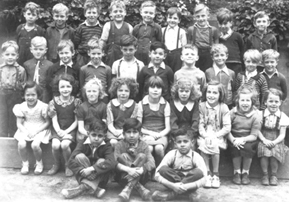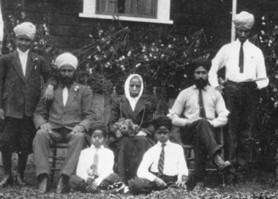





|

|
For the Sikhs, one of the advantages of coming to Canada was the opportunity for their children to get an education. Many Sikh parents,

|
Grade 1 class at Henry Hudson Elementary
school near Vancouver Sikh Temple
|
realizing the importance of learning English, sent their children to school for this reason alone. The Sikhs’ school experiences were mixed. It was
a traumatic experience for the ones who knew little English, since they had to start in grade one regardless of their age. Mr. Gurdave S. Billan
was fourteen years old when he was put in a grade one class at Henry Hudson school in Vancouver. Not surprisingly, he did not stay in school
long, but quit to sell wood with his uncle. This was the case with many of the children who came from India.
Sikh children also attended school in other parts of Vancouver.

|
|
Mr.Jagindar Singh Sangara
|
Mr. Jagindar S. Sangara, a Canadian-born Sikh, describes his experiences at
Moberly School in south Vancouver in 1930: " I was always speaking English. This one time, Dad came to school to talk to me and I said to him
not to come to school to see me because the other kids might think I’m an East Indian. I was the only East Indian kid at Moberly in those days. "
Mr. Piara S. Bains had a similar experience in Dollarton, in North Vancouver: " I went to school in Deep Cove from 1927 to 1929. At that time
there were mostly Japanese living there and I was the only East Indian kid at that time. I learned Japanese as well as English. "
What further diminished the value of education was that the Sikhs lacked the provincial, municipal and federal franchise. As a consequence,
many jobs and professions were not open to them. " They were simultaneously excluded from a host of other things that were dependent on
being a provincial voter, " writes Norman Buchignani. Although exclusion from the voters’ list did not legally restrict them from public service,
this became a universal practice. Public works contracts specified that they not be employed. The same restriction applied to the sale of Crown
timber, and the professions of law and pharmacy were informally closed to them. "
Most businesses would not hire Sikhs because of their marginal status; they believed them to be foreigners and not real Canadians. The Sikhs
all knew the names of highly educated Sikhs who, because of discriminatory hiring practices, went out of province – or, worse, ended up
working in the sawmills.
Most young Sikhs would gain a functional knowledge of English at school and, as soon as an opportunity for work presented itself, they would
quit school to begin working. Work had an immediate return in the form of wages. Education, on the other hand, was dependent on the future.
The Sikh’s future in British Columbia was never secure; they knew what they had with a job, they didn’t know what they would have with an
education.
Despite these obstacles, some Sikhs still went to great lengths to further their education. The Hundal boys who arrived in Canada in 1913 were

|
|
Hundal family
|
excellent students. They lived in Point Grey and went to Queen Mary Elementary and Prince of Wales High School, then on to the University of
BC. Iqbal (Ikball) earned a Bachelor of Science degree in mechanical engineering from the University of Washington in 1925 and went on to be
an aeronautical engineer in the United States. He also worked in the automobile industry in Oshawa, Ontario. Jermeja attended UBC and then
Oregon State College, and he worked for the Indian Consulate’s office in Los Angeles. Throughout their lives, the Hundal boys made every
effort to fit in with the dominant culture. They were always well-dressed and in style, and they socialized with all groups and joined clubs and
teams. But they still encountered discrimination in the job market, and so they both found employment outside the province.
|
cont...
[p.1]









|







